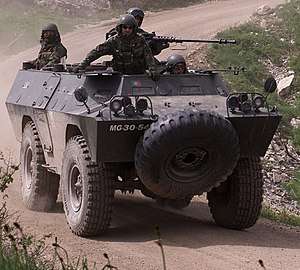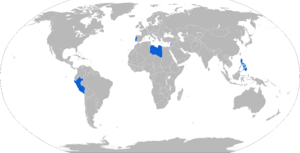Bravia Chaimite
| Bravia Chaimite | |
|---|---|
 Portuguese Chaimite V200 during Exercise Iberian Resolve, 2002. | |
| Type | Light Armoured Vehicle |
| Place of origin | Portugal |
| Service history | |
| In service | 1967–present |
| Used by | See Operators |
| Wars |
Portuguese Colonial War Lebanese Civil War Libyan Civil War |
| Production history | |
| Manufacturer | Bravia |
| No. built | over 600 |
| Variants | See Variants |
| Specifications | |
| Weight | 6.800 to 8500 kg |
| Length | 5.6 m |
| Width | 2.26 m |
| Height | 2.39 m |
| Crew | 1+10 |
|
| |
| Armor | up to 7.62 mm |
Main armament | depend of variant |
Secondary armament | depend of variant |
| Engine |
diesel engine 155 hp (115 kW) at 3300 rpm |
| Payload capacity | 804 kg |
| Transmission | automatic gearbox |
Operational range | 804 km |
| Speed |
99 km/h (62 mph) 4.8 km/h on water |
Steering system | rack & pinnion non assisted |
The Bravia Chaimite is an armored vehicle with all wheel drive axles built by the Portuguese company Bravia and used by the Portuguese Army in the Portuguese colonial wars in Angola, Mozambique and Portuguese Guinea, from 1967 to 1974 when it ended. The Chaimite was originally an unlicensed derivative of the Cadillac Gage Commando assembled and later produced in Portugal, with a number of improvements and technical modifications.[1]
There were two versions of the Chaimite, the VBTP V-200 and the VBPM V-600. The VBTP, (Viatura Blindada de Transporte de Pessoal, Armoured Personnel Transport Vehicle), had an 11-man capacity and was armed with one .50 Browning heavy machine-gun, while the VBPM, (Viatura Blindada Porta-morteiro, Armoured Mortar Carrier Vehicle), had only a 4-man capacity and was armed with one Browning .30 heavy machine-gun and one 81 mm mortar. These vehicles had diesel engines with 155 hp (115 kW) at 3300 rpm with automatic gear capable of taking on speeds to a maximum of 99 km/h (62 mph). The armour of this APC was capable of defeating rounds up to 7.62 mm NATO.
The Chaimite is now being gradually phased out of Portuguese Army service and replaced by the Austrian Pandur II 8x8 APC.
History
Designed in the mid 1960s for the Portuguese Army, in its original incarnation the Chaimite resembled a modified Cadillac Gage Commando, leading to speculation that Bravia had produced it under license from the United States.[1] A hearing held before the United States House of Representatives in 1977 verified that no such license had been granted, and that two former Cadillac Gage employees had been prosecuted for illegally transferring the technical knowledge for the Commando design to Bravia.[2]
The first prototype Chaimite appeared in 1966, and was designed primarily for direct fire support, with a large turret ring and braced chassis to carry a 90mm low-pressure cannon.[3] In 1968 or 1969 the prototype was sent to Portuguese Guinea for combat trials, where it performed well but was later destroyed by African Party for the Independence of Guinea and Cape Verde (PAIGC) insurgents with an RPG-2 or RPG-7.[3] The base Chaimite subsequently spawned several variants designed for internal security, anti-tank purposes, and medical evacuation.[4] By the time production ceased, over 600 had been manufactured for the Portuguese Army and export.[5]
Variants
- V-200: armoured personnel carrier
- V-200 Armada 60: special variant for the Portuguese Marines of the V-200 armed with a multiple 60 mm rocket launcher
- V-300: light fire support with 7.62 NATO to 20 mm gun
- V-400: heavy fire support with 90mm or 75mm low-pressure gun
- V-500: communications and command vehicle
- V-600: mortar carrier with 81 mm or 120 mm mortars
- V-700: anti-tank with Swingfire or HOT missile launcher
- V-800: ambulance
- V-900: armoured recovery vehicle
- V-1000: anti-riot with water cannon
Operators

Current operators
Former operators
- Guardians of the Cedars – some captured from the Internal Security Forces in 1976.[7]

- Tigers Militia – some captured from the Internal Security Forces in 1976, and returned to their ownership in 1980.
Popular culture
The Chaimite made some major film appearances, notably in the 1993 movie The House of Spirits, portraying Chilean Army APCs in action during the September 1973 military coup d'etat and in the 2002 movie The Dancer Upstairs, in the colours of an undisclosed Latin American Army. It was also featured in the 2000 film April Captains, set in during the Portuguese Carnation Revolution of April 1974.
See also
- Battle of the Hotels
- Bravia Commando MK III APC
- Cadillac Gage Commando
Notes
- 1 2 Christopher F. Foss. Jane's World Armoured Fighting Vehicles (1976 ed.). Macdonald and Jane's Publishers Ltd. pp. 290–293. ISBN 0-354-01022-0.
- ↑ United States-South Africa Relations: Arms Embargo Implementation: Hearings Before the Subcommittee on Africa of the Committee on International Relations, House of Representatives, Ninety-fifth Congress, First Session, July 14 and 20, 1977 (Report) (First ed.). Washington D.C.: Government Printing Office. July 1977. p. 63. Retrieved 28 June 2017.
The assertion was made here last week that a Portuguese firm, Bravia, had produced V-150 personnel carriers under license...from Cadillac Gage of Detroit. This statement is false. The facts are that two former employees of Cadillac Gage stole technical data and conveyed it to the Portuguese firm. When this was discovered by the U.S. Government, the two former employees were prosecuted for illegally transferring the technology, and were convicted and sentenced.
- 1 2 Coutinho, Pereira (May–August 2012). "Exército Português Auto-Metralhadoras" (PDF). Revista da Cavalaria. 3 (27): 6–10. Archived from the original (PDF) on December 20, 2014.
- 1 2 Christopher F. Foss. Jane's Tanks and Combat Vehicles Recognition Guide (2000 ed.). Harper Collins Publishers. pp. 122–123. ISBN 978-0-00-472452-2.
- ↑ Christopher F. Foss. Jane's Armour and Artillery (2002 ed.). Macdonald and Jane's Publishers Ltd. p. 482. ISBN 978-0710623096.
- 1 2 3 4 "Trade Registers". Armstrade.sipri.org. Retrieved 2013-06-20.
- ↑ http://milinme.wordpress.com/category/v-200-chaimite – An ex-ISF V-200 Chaimite employed by the Guardians of the Cedars pictured at Houche-el-Oumara during the Battle of Zahleh, April–June 1981.
- ↑ http://www.ecsbdefesa.com.br/fts/Chaimite
References
- Christopher F. Foss, Jane's Tank and Combat Vehicle Recognition Guide, HarperCollins Publishers, London 2002. ISBN 0-00-712759-6